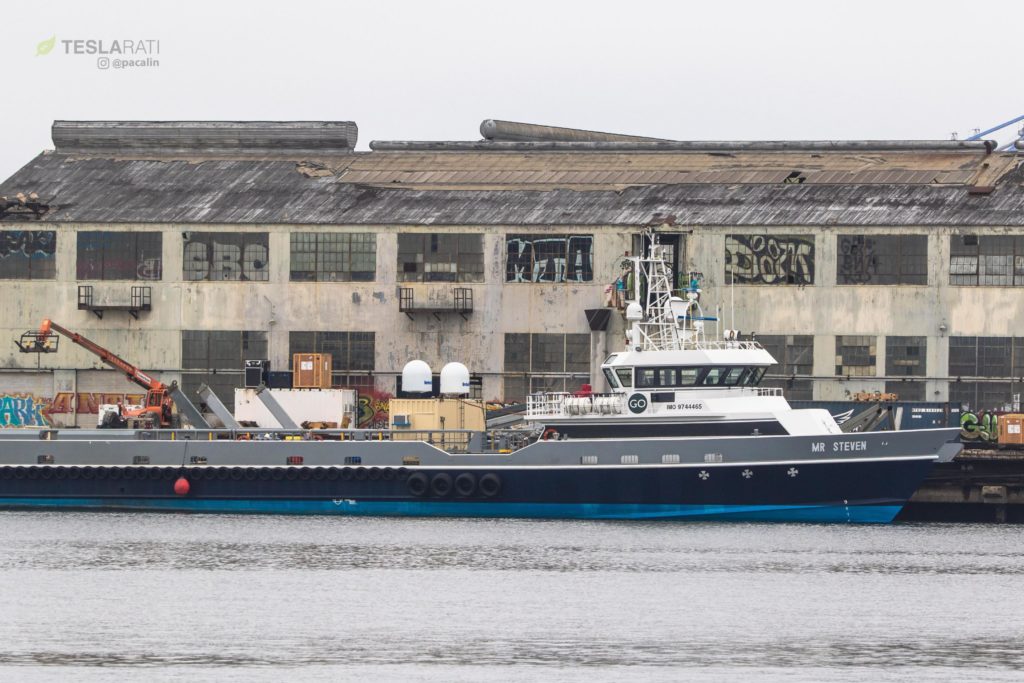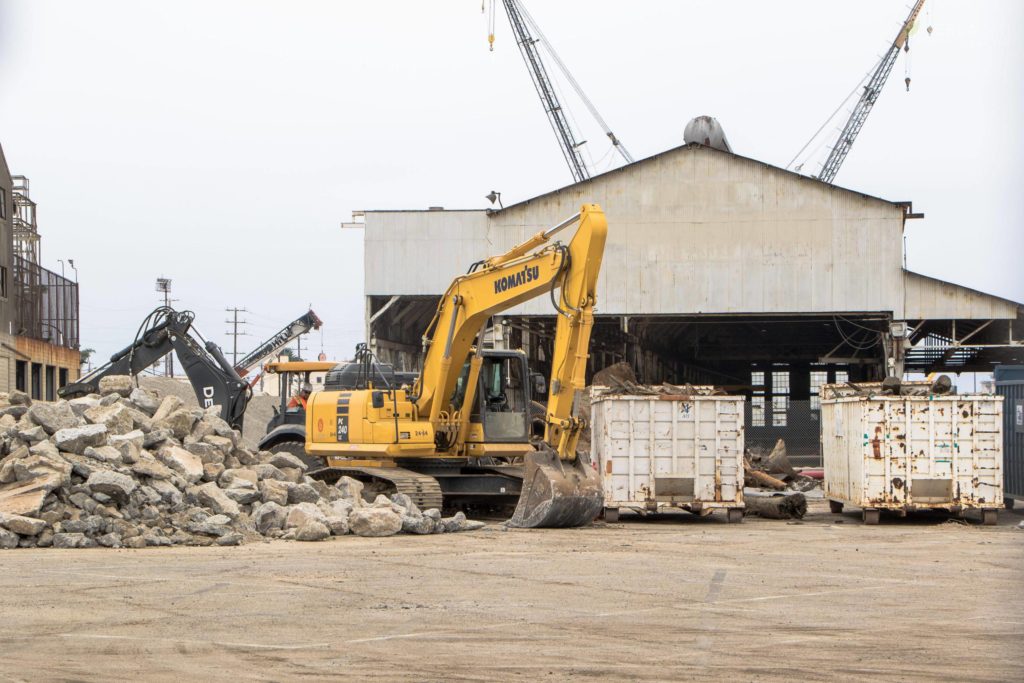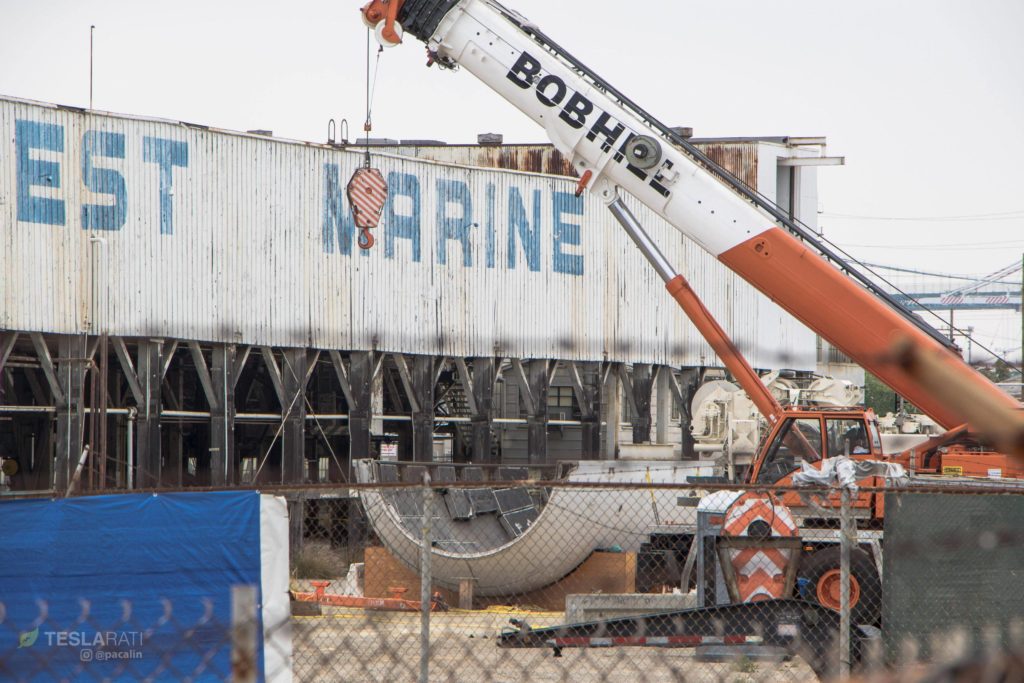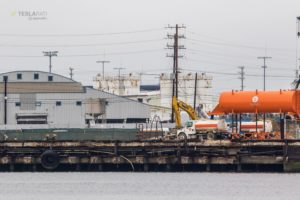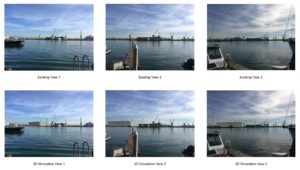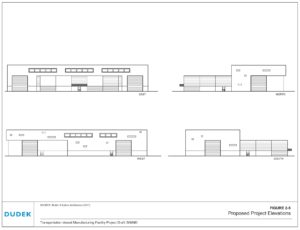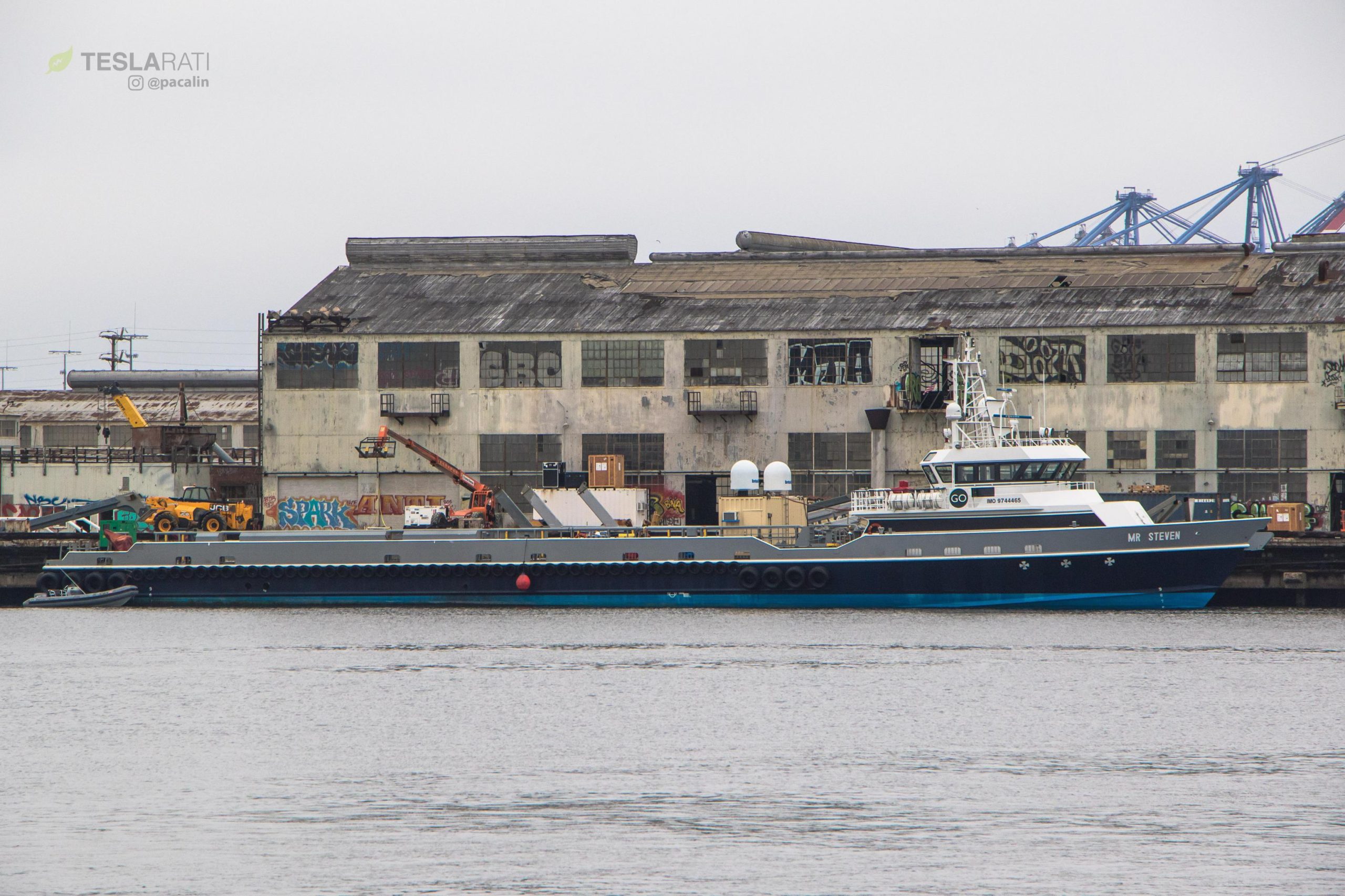
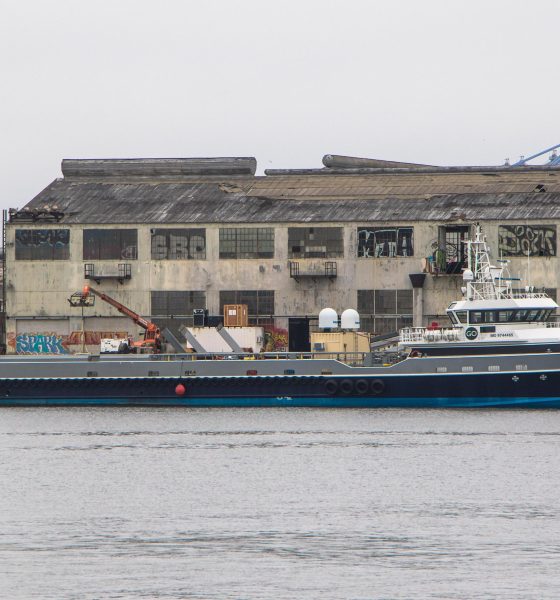
SpaceX
SpaceX’s Mr Steven preps for “claw” upgrade for football field-sized net
Photos from Teslarati photographer Pauline Acalin show that SpaceX’s Mr. Steven fairing recovery vessel is undergoing extensive upgrades to the arms that secure the catch net, likely in support of what CEO Elon Musk described as a factor-of-four extension of the net’s catching area.
In order to accomplish that fourfold increase in usable area, SpaceX will have to effectively double the reach of Mr Steven’s four ‘limbs’, a significant change that explains why the vessel appears to have had all four arms amputated. Intriguingly, the vessel’s upgrades are taking place at SpaceX’s recently-leased Berth 240, the company’s preferred location for berthing its fleet of rocket recovery vessels, conducting Falcon 9 booster recovery ops, and -eventually – the first Mars rocket factory in 2019.
As of now, it’s unclear what approach SpaceX will take for upgrading Mr Steven’s arms – with only one detached example visible at Berth 240, it appears that the company will either add on to the hardware already built for the boat or start from scratch in order to optimally extend their reach. A new net, of course, will also be needed to span the fourfold increase in area – in other words, up to roughly 6000 square meters, 65,000 square feet, or 1.5 acres. I have little doubt that SpaceX will be able to reliably catch Falcon 9 payload fairings with a net as large or larger than American and European football fields (~1.3 acres vs. ~1.7 acres).

An artist rendering of a Falcon 9 fairing parasailing towards Mr Steven’s net. Original photos by Chuck Bennett (Instagram @chuckbennett) and SpaceX. (Chuck Bennet/SpaceX/Eric Ralph)
SpaceX’s has roughly four weeks until their next West coast launch and thus another opportunity to attempt to catch a Falcon 9 payload fairing. That mission is currently scheduled for early July 20th from Space Launch Complex 4E (SLC-4E) in Vandenberg Air Force Base. Teslarati’s West coast photographer will continue to check up on Mr Steven to judge whether the vessel will be ready in time for launch.
- One of Mr Steven’s four amputated arms, removed in preparation for upgrades. (Pauline Acalin)
- A sad Mr Steven sits beside Berth 240, sans arms. (Pauline Acalin)
- Berth 240 demolition begins! (Pauline Acalin)
- A Falcon 9 fairing overlooks SpaceX’s Berth 240 construction progress, June 20th. (Pauline Acalin)
BFR factory construction
Meanwhile, serious demolition has begun at Berth 240, likely preparing a number of basic necessities before any major building begins. A giant pile of broken concrete lays witness to that process, likely involving the appraisal, repair, and replacement of utilities and pipe systems currently buried under the facility. Forlorn Falcon 9 payload fairings – pulled intact out of the Pacific Ocean – can be seen stoically looking on while construction crews begin the first steps of a process that will, at least eventually, culminate in the completion of a factory for the rocket that will obsolete Falcon 9, Falcon Heavy, and their fairings.
Based on land use approvals published in March 2018, the construction will be cut into two phases, with phase one focusing on a smaller, intermediary building capable of support limited Falcon recovery work and potentially initial BFR prototype construction, allowing that process to be moved from the temporary tent it currently is housed in. Phase 2 would see a larger build constructed around the preceding facility, necessitating the demolition of one of Berth 240’s historic buildings. Per the filings, Phase 1 is expected to be finished within 16-18 months of approval, placing its completion sometime in mid to late 2019.
- Note the fencing around the actual foundation site for SpaceX’s proposed BFR factory. (Pauline Acalin)
- Renders of the proposed BFR factory at Berth 240. (SpaceX)
- Blueprints of the proposed BFR factory at Berth 240. (SpaceX)

Elon Musk
Starlink achieves major milestones in 2025 progress report
Starlink wrapped up 2025 with impressive growth, adding more than 4.6 million new active customers and expanding service to 35 additional countries, territories, and markets.

Starlink wrapped up 2025 with impressive growth, adding more than 4.6 million new active customers and expanding service to 35 additional countries, territories, and markets. The company also completed deployment of its first-generation Direct to Cell constellation, launching over 650 satellites in just 18 months to enable cellular connectivity.
SpaceX highlighted Starlink’s impressive 2025 progress in an extensive report.
Key achievements from Starlink’s 2025 Progress
Starlink connected over 4.6 million new customers with high-speed internet while bringing service to 35 more regions worldwide in 2025. Starlink is now connecting 9.2 million people worldwide. The service achieved this just weeks after hitting its 8 million customer milestone.
Starlink is now available in 155 markets, including areas that are unreachable by traditional ISPs. As per SpaceX, Starlink has also provided over 21 million airline passengers and 20 million cruise passengers with reliable high-speed internet connectivity during their travels.
Starlink Direct to Cell
Starlink’s Direct to Cell constellation, more than 650 satellites strong, has already connected over 12 million people at least once, marking a breakthrough in global mobile coverage.
Starlink Direct to Cell is currently rolled out to 22 countries and 6 continents, with over 6 million monthly customers. Starlink Direct to Cell also has 27 MNO partners to date.
“This year, SpaceX completed deployment of the first generation of the Starlink Direct to Cell constellation, with more than 650 satellites launched to low-Earth orbit in just 18 months. Starlink Direct to Cell has connected more than 12 million people, and counting, at least once, providing life-saving connectivity when people need it most,” SpaceX wrote.
Elon Musk
Starlink passes 9 million active customers just weeks after hitting 8 million
The milestone highlights the accelerating growth of Starlink, which has now been adding over 20,000 new users per day.

SpaceX’s Starlink satellite internet service has continued its rapid global expansion, surpassing 9 million active customers just weeks after crossing the 8 million mark.
The milestone highlights the accelerating growth of Starlink, which has now been adding over 20,000 new users per day.
9 million customers
In a post on X, SpaceX stated that Starlink now serves over 9 million active users across 155 countries, territories, and markets. The company reached 8 million customers in early November, meaning it added roughly 1 million subscribers in under seven weeks, or about 21,275 new users on average per day.
“Starlink is connecting more than 9M active customers with high-speed internet across 155 countries, territories, and many other markets,” Starlink wrote in a post on its official X account. SpaceX President Gwynne Shotwell also celebrated the milestone on X. “A huge thank you to all of our customers and congrats to the Starlink team for such an incredible product,” she wrote.
That growth rate reflects both rising demand for broadband in underserved regions and Starlink’s expanding satellite constellation, which now includes more than 9,000 low-Earth-orbit satellites designed to deliver high-speed, low-latency internet worldwide.
Starlink’s momentum
Starlink’s momentum has been building up. SpaceX reported 4.6 million Starlink customers in December 2024, followed by 7 million by August 2025, and 8 million customers in November. Independent data also suggests Starlink usage is rising sharply, with Cloudflare reporting that global web traffic from Starlink users more than doubled in 2025, as noted in an Insider report.
Starlink’s momentum is increasingly tied to SpaceX’s broader financial outlook. Elon Musk has said the satellite network is “by far” the company’s largest revenue driver, and reports suggest SpaceX may be positioning itself for an initial public offering as soon as next year, with valuations estimated as high as $1.5 trillion. Musk has also suggested in the past that Starlink could have its own IPO in the future.
News
SpaceX shades airline for seeking contract with Amazon’s Starlink rival

SpaceX employees, including its CEO Elon Musk, shaded American Airlines on social media this past weekend due to the company’s reported talks with Amazon’s Starlink rival, Leo.
Starlink has been adopted by several airlines, including United Airlines, Qatar Airways, Hawaiian Airlines, WestJet, Air France, airBaltic, and others. It has gained notoriety as an extremely solid, dependable, and reliable option for airline travel, as traditional options frequently cause users to lose connection to the internet.
Many airlines have made the switch, while others continue to mull the options available to them. American Airlines is one of them.
A report from Bloomberg indicates the airline is thinking of going with a Starlink rival owned by Amazon, called Leo. It was previously referred to as Project Kuiper.
American CEO Robert Isom said (via Bloomberg):
“While there’s Starlink, there are other low-Earth-orbit satellite opportunities that we can look at. We’re making sure that American is going to have what our customers need.”
Isom also said American has been in touch with Amazon about installing Leo on its aircraft, but he would not reveal the status of any discussions with the company.
The report caught the attention of Michael Nicolls, the Vice President of Starlink Engineering at SpaceX, who said:
“Only fly on airlines with good connectivity… and only one source of good connectivity at the moment…”
CEO Elon Musk replied to Nicolls by stating that American Airlines risks losing “a lot of customers if their connectivity solution fails.”
American Airlines will lose a lot of customers if their connectivity solution fails
— Elon Musk (@elonmusk) December 14, 2025
There are over 8,000 Starlink satellites in orbit currently, offering internet coverage in over 150 countries and territories globally. SpaceX expands its array of satellites nearly every week with launches from California and Florida, aiming to offer internet access to everyone across the globe.
Currently, the company is focusing on expanding into new markets, such as Africa and Asia.

